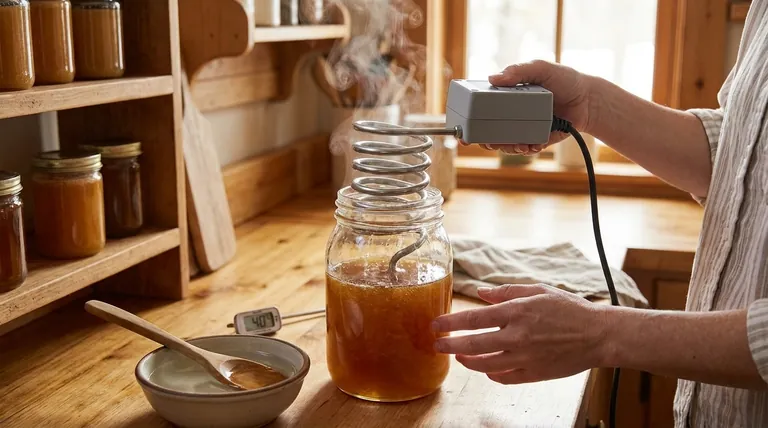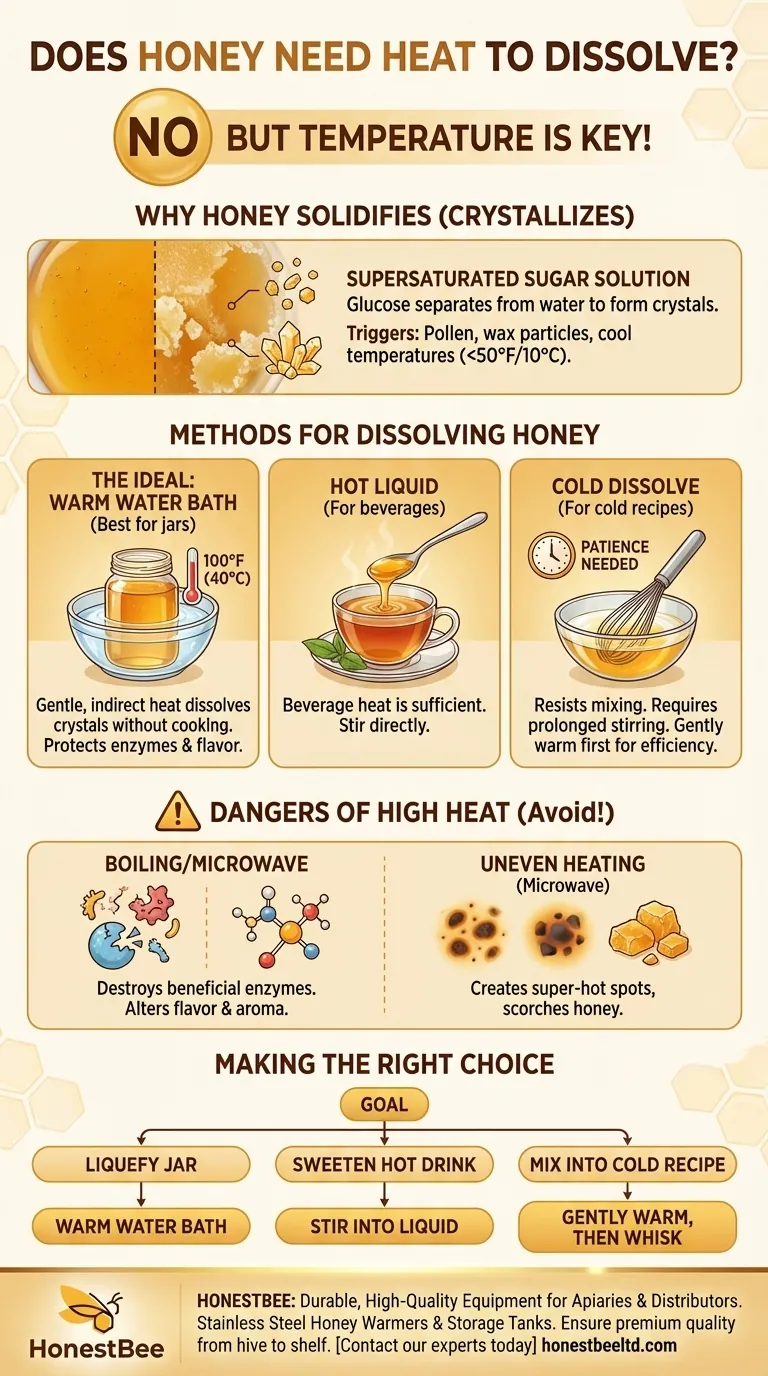No, honey does not strictly require heat to dissolve, but temperature is the single most important factor in how quickly it happens. Honey is a supersaturated solution of sugars that will eventually mix into a liquid on its own with enough time and agitation. However, applying gentle heat is the most practical and efficient way to dissolve the glucose crystals that cause it to solidify.
Honey's tendency to crystallize is a natural sign of its purity, not spoilage. While it can dissolve in cold liquids with persistent stirring, applying gentle, controlled warmth is the key to efficiently returning it to a smooth, liquid state without damaging its delicate enzymes and aromas.

Why Honey Solidifies (Crystallizes)
To understand how to dissolve honey, it’s essential to first understand its composition. This knowledge is the foundation for handling it correctly.
A Supersaturated Sugar Solution
Honey contains more sugar—primarily glucose and fructose—than can technically remain dissolved in its small amount of water. This makes it an unstable, "supersaturated" solution, always on the verge of solidifying.
The Role of Glucose
Crystallization occurs when glucose, which is less soluble in water than fructose, begins to separate from the water. These glucose molecules then form small, solid crystals.
Common Triggers for Crystallization
The process is often kick-started by small particles in the honey, such as pollen or wax, which act as "seeds" for crystals to grow. Cooler storage temperatures (below 50°F or 10°C) also significantly accelerate crystallization.
Methods for Dissolving Honey
Your approach should depend on whether the honey is crystallized in its jar or if you are simply mixing it into a beverage or recipe.
The Ideal Method: The Warm Water Bath
This is the best practice for returning a full jar of crystallized honey to a liquid state. Place your container of honey in a bowl of warm water, around 100°F (40°C). The gentle, indirect heat will dissolve the crystals without "cooking" the honey.
Dissolving in a Hot Liquid
If you're adding honey to hot tea or coffee, no pre-warming is needed. The heat from the beverage is more than enough to dissolve the honey quickly as you stir it in.
The Cold Dissolve: A Matter of Patience
You can dissolve honey in a cold liquid, like iced tea or a vinaigrette. However, it will resist mixing and require significant, prolonged stirring or whisking to fully incorporate. It is far more efficient to gently warm the honey first.
Understanding the Trade-offs: The Dangers of High Heat
While heat is helpful, excessive heat will permanently damage the honey. This is the most common mistake people make.
Degrading Beneficial Enzymes
High temperatures, especially from boiling or microwaving, will destroy the naturally occurring enzymes (like diastase and invertase) that are among honey's valued properties.
Altering Flavor and Aroma
The delicate floral notes that make each honey variety unique are volatile. Overheating will cook these compounds away, leaving you with a generic, overly sweet syrup.
The Microwave Pitfall
Microwaving is the worst way to warm honey. It heats unevenly, creating super-hot spots that scorch and damage the honey while other parts remain solid. This process can happen in seconds.
Making the Right Choice for Your Goal
Always match your method to your specific objective to preserve the honey's quality.
- If your primary focus is returning a crystallized jar to liquid form: Use a gentle warm water bath around 100°F (40°C) to protect its enzymes and flavor.
- If your primary focus is sweetening a hot beverage: Simply stir the honey directly into the liquid, as the beverage itself provides the necessary warmth.
- If your primary focus is mixing honey into a cold recipe: Gently liquefy the honey with a warm water bath first, then slowly whisk it into your other ingredients for smooth integration.
By understanding honey's simple relationship with temperature, you can ensure you are always using it effectively while preserving its natural integrity.
Summary Table:
| Method | Best For | Key Temperature |
|---|---|---|
| Warm Water Bath | Liquefying a full jar | ~100°F (40°C) |
| Hot Liquid | Sweetening tea/coffee | Beverage's heat |
| Cold Dissolve | Mixing into cold recipes | Requires patience & stirring |
For beekeepers and distributors, proper honey handling is essential for quality.
HONESTBEE supplies the durable, high-quality beekeeping equipment—like stainless steel honey warmers and storage tanks—that commercial apiaries and distributors rely on to maintain product integrity. Ensure your honey retains its premium quality from hive to shelf.
Contact our experts today to discuss wholesale solutions for your operation.
Visual Guide

Related Products
- Professional Thermostatic Conical Honey Melter
- Honey Concentrating Vacuum Heating Thickening Machine Dehumidifier for Honey
- HONESTBEE 72 Frame Industrial Electric Honey Extractor for Beekeeping
- 8-Frame Electric Self-Reversing Honey Extractor Spinner for Commercial Honey Extraction Equipment
- High Quality Honey Dehumidifier Dryer Thickening Machine for Beekeeping
People Also Ask
- Why is heating honey sometimes necessary? The Essential Guide to Processing & Quality
- Is it safe to heat crystallized honey? Restore Your Honey's Liquid State Safely
- What is melter honey used for? A Low-Cost Ingredient for Bakers and Brewers
- Why is it important to heat honey slowly and evenly? Preserve Flavor, Nutrients & Value
- How does the Bee Blanket help maintain honey quality? Preserve Enzymes with Gentle Hive-Mimicking Heat



















